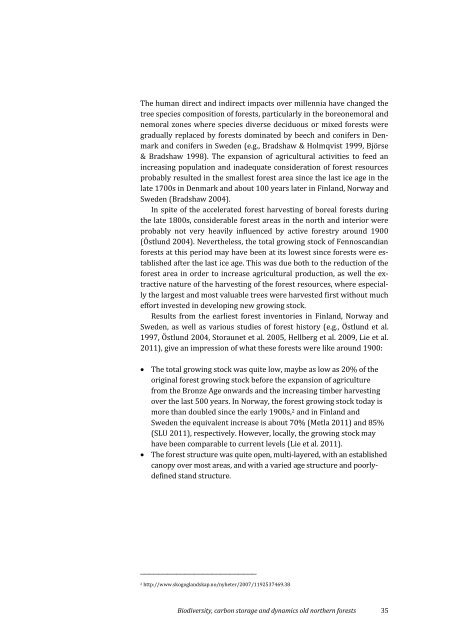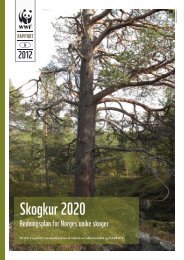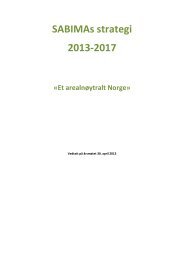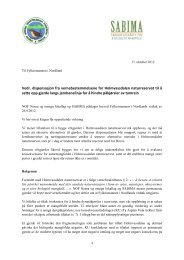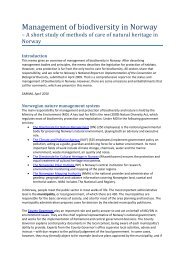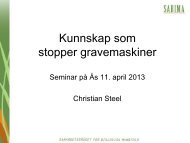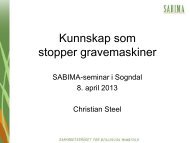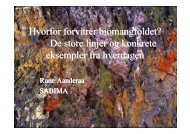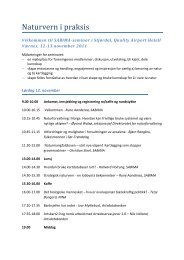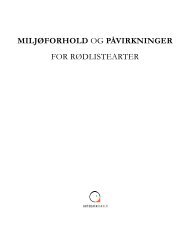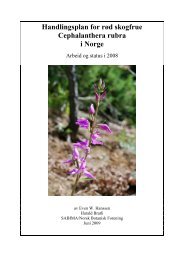Biodiversity, carbon storage and dynamics of old northern ... - BPAN.fi
Biodiversity, carbon storage and dynamics of old northern ... - BPAN.fi
Biodiversity, carbon storage and dynamics of old northern ... - BPAN.fi
You also want an ePaper? Increase the reach of your titles
YUMPU automatically turns print PDFs into web optimized ePapers that Google loves.
The human direct <strong>and</strong> indirect impacts over millennia have changed the<br />
tree species composition <strong>of</strong> forests, particularly in the boreonemoral <strong>and</strong><br />
nemoral zones where species diverse deciduous or mixed forests were<br />
gradually replaced by forests dominated by beech <strong>and</strong> conifers in Denmark<br />
<strong>and</strong> conifers in Sweden (e.g., Bradshaw & Holmqvist 1999, Björse<br />
& Bradshaw 1998). The expansion <strong>of</strong> agricultural activities to feed an<br />
increasing population <strong>and</strong> inadequate consideration <strong>of</strong> forest resources<br />
probably resulted in the smallest forest area since the last ice age in the<br />
late 1700s in Denmark <strong>and</strong> about 100 years later in Finl<strong>and</strong>, Norway <strong>and</strong><br />
Sweden (Bradshaw 2004).<br />
In spite <strong>of</strong> the accelerated forest harvesting <strong>of</strong> boreal forests during<br />
the late 1800s, considerable forest areas in the north <strong>and</strong> interior were<br />
probably not very heavily influenced by active forestry around 1900<br />
(Östlund 2004). Nevertheless, the total growing stock <strong>of</strong> Fennosc<strong>and</strong>ian<br />
forests at this period may have been at its lowest since forests were established<br />
after the last ice age. This was due both to the reduction <strong>of</strong> the<br />
forest area in order to increase agricultural production, as well the extractive<br />
nature <strong>of</strong> the harvesting <strong>of</strong> the forest resources, where especially<br />
the largest <strong>and</strong> most valuable trees were harvested <strong>fi</strong>rst without much<br />
effort invested in developing new growing stock.<br />
Results from the earliest forest inventories in Finl<strong>and</strong>, Norway <strong>and</strong><br />
Sweden, as well as various studies <strong>of</strong> forest history (e.g., Östlund et al.<br />
1997, Östlund 2004, Storaunet et al. 2005, Hellberg et al. 2009, Lie et al.<br />
2011), give an impression <strong>of</strong> what these forests were like around 1900:<br />
The total growing stock was quite low, maybe as low as 20% <strong>of</strong> the<br />
original forest growing stock before the expansion <strong>of</strong> agriculture<br />
from the Bronze Age onwards <strong>and</strong> the increasing timber harvesting<br />
over the last 500 years. In Norway, the forest growing stock today is<br />
more than doubled since the early 1900s, 2 <strong>and</strong> in Finl<strong>and</strong> <strong>and</strong><br />
Sweden the equivalent increase is about 70% (Metla 2011) <strong>and</strong> 85%<br />
(SLU 2011), respectively. However, locally, the growing stock may<br />
have been comparable to current levels (Lie et al. 2011).<br />
The forest structure was quite open, multi-layered, with an established<br />
canopy over most areas, <strong>and</strong> with a varied age structure <strong>and</strong> poorlyde<strong>fi</strong>ned<br />
st<strong>and</strong> structure.<br />
──────────────────────────<br />
2 http://www.skogogl<strong>and</strong>skap.no/nyheter/2007/1192537469.38<br />
<strong>Biodiversity</strong>, <strong>carbon</strong> <strong>storage</strong> <strong>and</strong> <strong>dynamics</strong> <strong>old</strong> <strong>northern</strong> forests 35


